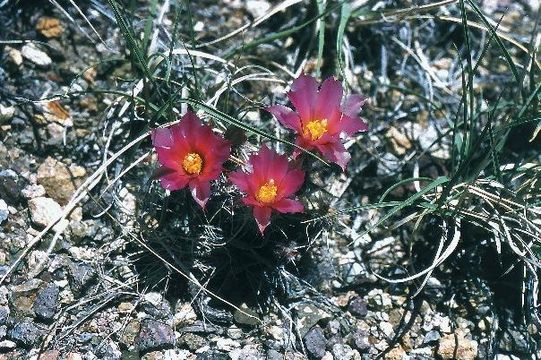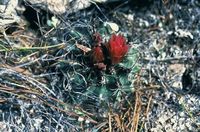Sclerocactus spinosior
|
|
|
|
Family: Cactaceae
Desert Valley Fish-Hook Cactus, more...desert valley fishhook cactus
[Echinocactus whipplei var. spinosior Engelm., moreFerocactus spinosior (Engelm.) N.P. Taylor, Pediocactus spinosior (Engelm.) Halda, Sclerocactus pubispinus var. sileri L. Benson, Sclerocactus pubispinus var. spinosior (Engelm.) Welsh, Sclerocactus whipplei var. spinosior (Engelm.) Boissevain] |
Stems usually unbranched, light green to dark green, ovoid or cylindric, 2-15(-23) × 1-10(-15) cm, glaucous; ribs (11-)13-14, tubercles prominent on ribs. Spines frequently obscuring stems; radial spines 6-10(-12) per areole, spreading, tipped white or dark, 10-35 × 0.3-1 mm; central spines (2-)4-6 per areole; abaxial centrals (1-)3 per areole, reddish to black, less often tan to brown, usually 1-2 hooked, except some older areoles, 20-40 mm; lateral central spines usually 2 per areole, tan, red, or reddish brown, terete, 10-30 mm; adaxial central spines 1(-3) white, flattened, 20-60 × 0.7-1.6 mm. Flowers narrowly funnelform to campanulate, 2-5 × 1-4 cm; outer tepals with greenish brown or reddish brown midstripes and pink, violet-pink, or reddish purple margins, usually oblanceolate, 10-20 × 4-7 mm, usually mucronate, margins nearly entire; inner tepals reddish purple to lavender, oblanceolate to narrowly oblanceolate, 15-25 × 6-8 mm, margins paler, nearly entire; filaments yellow, green, red-violet, or pink; anthers yellow; styles minutely and sparsely papillate. Fruits dehiscent along 2-4 vertical slits, green to pink or pale red, barrel-shaped, 9-13 × 8-12 mm, dry; scales few, membranous, scarious-margined. Seeds black, 2-2.5 × 2.5-3 mm; testa with rounded papillae. Flowering late Apr-May. Igneous or calcareous gravels, sagebrush and shadscale flats, pinyon-juniper woodlands; 1500-2000 m; Utah. Sclerocactus spinosior is morphologically similar to S. pubispinus and S. blainei (see discussions of those species). There is a variety of taxonomic opinions for handling species boundaries of S. spinosior. F. Hochstätter (1997) treated S. blainei at the subspecific level under S. spinosior; whereas S. L. Welsh (1984b) included S. spinosior as a variety of S. pubispinus. Phylogenetic analyses of chloroplast DNA sequences (J. M. Porter et al. 2000) provided evidence of close relationship among S. spinosior, S. pubispinus, and S. blainei, but no specific sister-group relationship for S. spinosior. Here we maintain all three at the rank of species.
STEMS: 1(-2), depressed globose, up to 5.5 cm long, 3.5-5.5 cm in diameter, green; ribs usually 13, poorly developed; tubercles 7-12 mm long, 6-15 mm broad and protruding above the ribs. SPINES: 4, 1.2-3 cm long, 0.5-1 mm wide, the lowest one white, gray or purple tinged, angled, strongly hooked, slightly contorted, turned or curving somewhat downward, the lateral central spines 2, similar to the lowest one but a bit shorter, and usually not hooked, the uppermost central spine 1.3-3 cm long, 0.75-2 mm wide, white to tan, recurved, strongly flattened, conspicuous, erect; radial spines 6-8, basally 0.5-0.75 mm wide, acicular, elliptic in cross-section. FLOWERS: 2.5-3 cm long, 2-3 cm in diameter; external floral tube glabrous; outer tepals 10-15 mm long, 5-8 mm broad, with brownish midrib and yellowish margins, the larger ones oblanceolate, mucronate, marginally membranous and crisped or minutely toothed; inner tepals 15-25 mm long, 5-7 mm at the broadest point, yellow, sometimes suffused with brown, the largest lanceolate, mucronate; filaments white, 7-10 mm long; anthers yellow; style papillose; yellowish-green, stigma lobes 5-8. FRUITS: ovoid, 0.8-2.2 cm long, 0.8-1.4 cm broad, green, turning red, with a few membranous scarious-margined, minutely toothed or fimbriate scales, opening along 2-4 vertical slits. SEEDS: 2.3-2.5 mm long, 2.7-3 mm diameter, pyriform, black. NOTES: Rocky and sandy soils in desert grasslands and pinyon-juniper woodlands: endemic to Coconino co.; 1360-1800 m (4500-6000 ft); May-Jun. REFERENCES: Heil, Kenneth D., and Mark J. Porter. 2001. Cactaceae. J. Ariz. - Nev. Acad. Sci. Volume 33(1) |


